28 Wild Animals in Botswana [Wildlife in Botswana]
Want to know more about the wildlife in Botswana?
Discover 28 wild animals in Botswana in this post, as well as interesting facts about them. 🇧🇼
Learn All About Botswana Animals
Ready to learn all about Botswana animals?
I’ve always been fascinated by animals, and by how they can be so different from one country to another. In this guide, we’ll focus on the many animals Botswana has on the land, in the sky, and underwater.
I’ve split the guide into 4 categories:
- Native animals from Botswana
- Endangered animals of Botswana
- What is Botswana national animal?
- How many animals native to Botswana?
Let’s dive in right away with our first category!
Native Animals from Botswana
Botswana is a landlocked African country located in the southern part of the continent. While it used to be extremely poor at the end of the 1960s, its economy was developed to now become one of the fastest-growing ones. It is bordered by Zimbabwe, Namibia, and South Africa. Its capital city is Gaborone, which counts more than 231,000 inhabitants (but more than 421,000 if you include the metropolitan area).
An interesting part of the country that I wanted to tackle is its wildlife. In light of that, I have listed the best of it, and I hope you will love learning what animals live in Botswana.
Here’s the Botswana animals list.
1. Eastern cattle egret
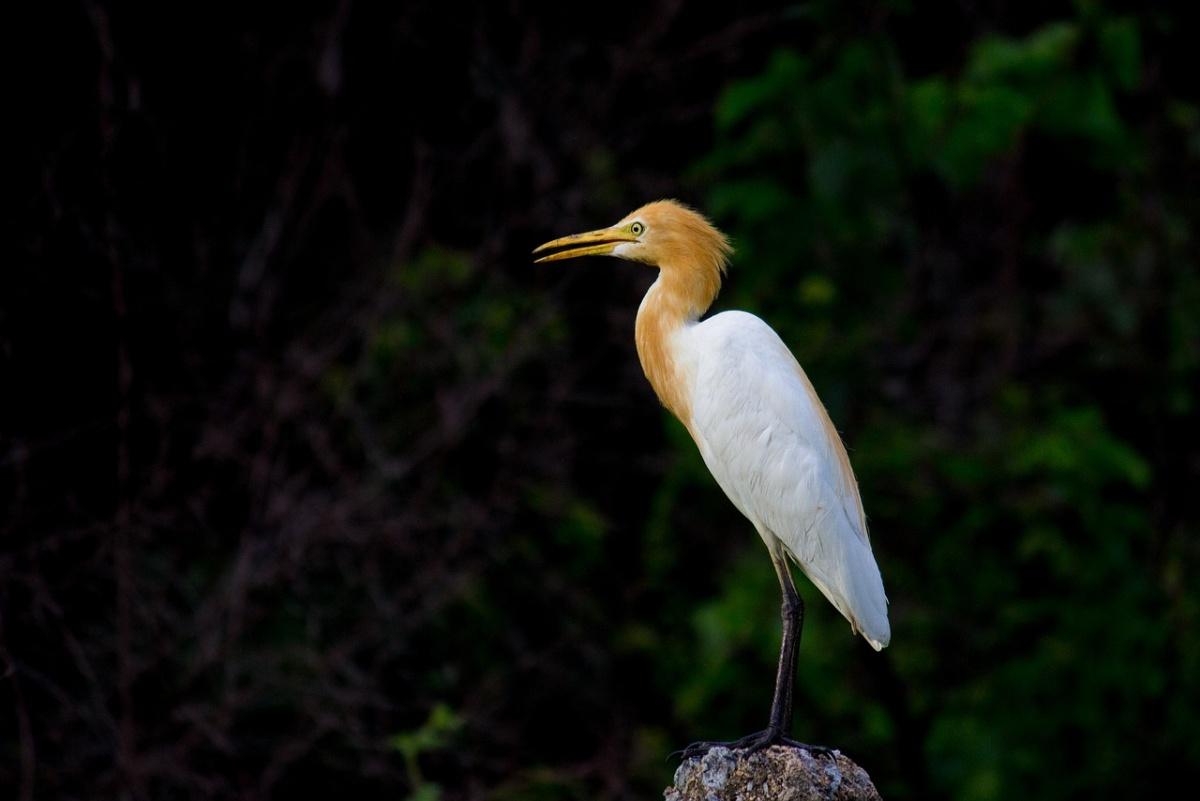
- Name: Eastern cattle egret
- Scientific name: Bubulcus coromandus
- Conservation status:
The eastern cattle egret is the national bird of Botswana. It is a species of heron that can be found in warm, tropical, and subtropical areas. It does not have many predators as an adult, but nests can be raided by mammals or other birds.
The diet of the eastern cattle egret is very varied, but it is mostly made of insects and moths. Occasionally, it can also feed on worms, spiders, and frogs.
2. Aardwolf
- Name: Aardwolf
- Scientific name: Proteles cristata
- Conservation status:
You might have never heard of it. The aardwolf is a species of insectivorous mammal native to southern and eastern Africa. One of its other names is the civet hyena, due to its habit of secreting substances from its anal gland, just like the African civet.
Aardwolf means “earth wolf” in Afrikaans and Dutch, and it inhabits open areas with trees and shrubs. During the day, it rests in burrows, and it only emerges at night to find food.
3. Cape vulture
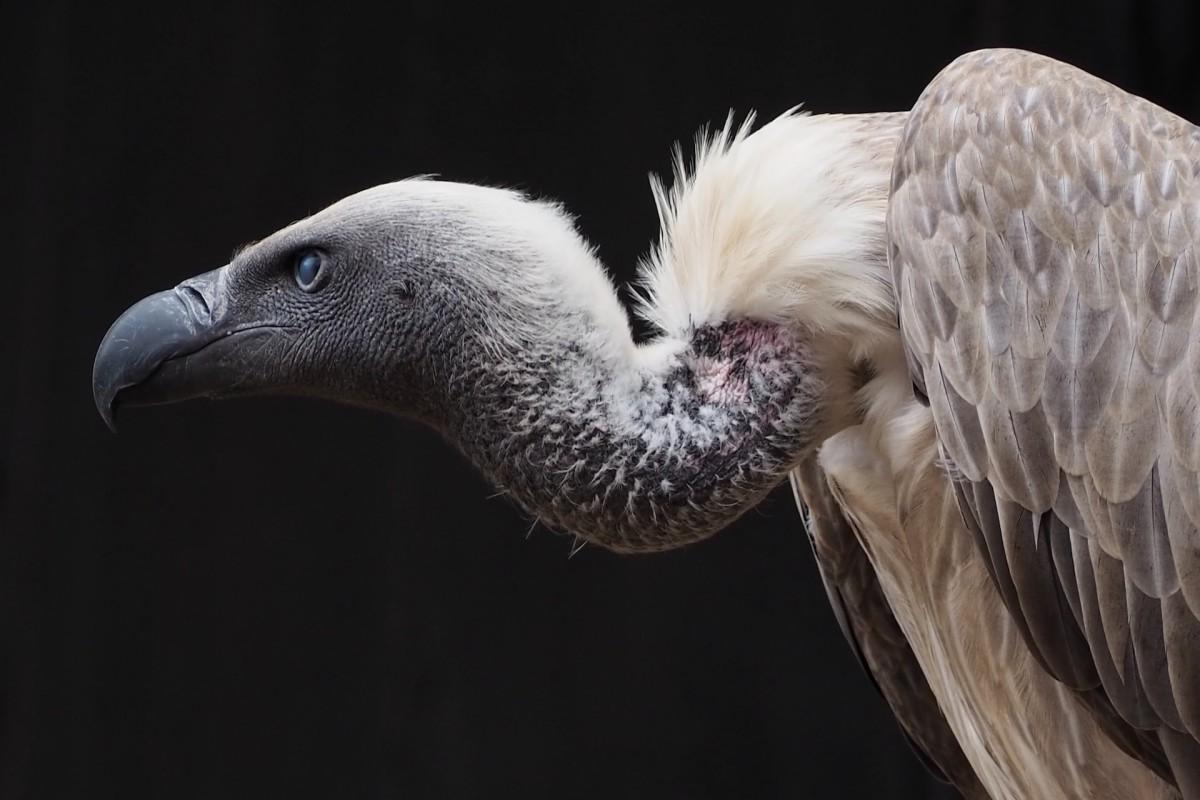
- Name: Cape vulture
- Scientific name: Gyps coprotheres
- Conservation status:
The Cape vulture, also known as Kolbe’s vulture or Cape griffon, is a species of vulture endemic to southern Africa, including Botswana, Lesotho, Namibia, and South Africa. It lays one egg per year, and usually nests on cliffs.
This vulture is sadly endangered, and its population has been steadily decreasing since the end of the 1980s. It is threatened by poisoning, a decrease in the amount of large carrion, and electrocution on electricity pylons, their biggest threat. There are now around 9,400 mature wild individuals.
4. African bush elephant
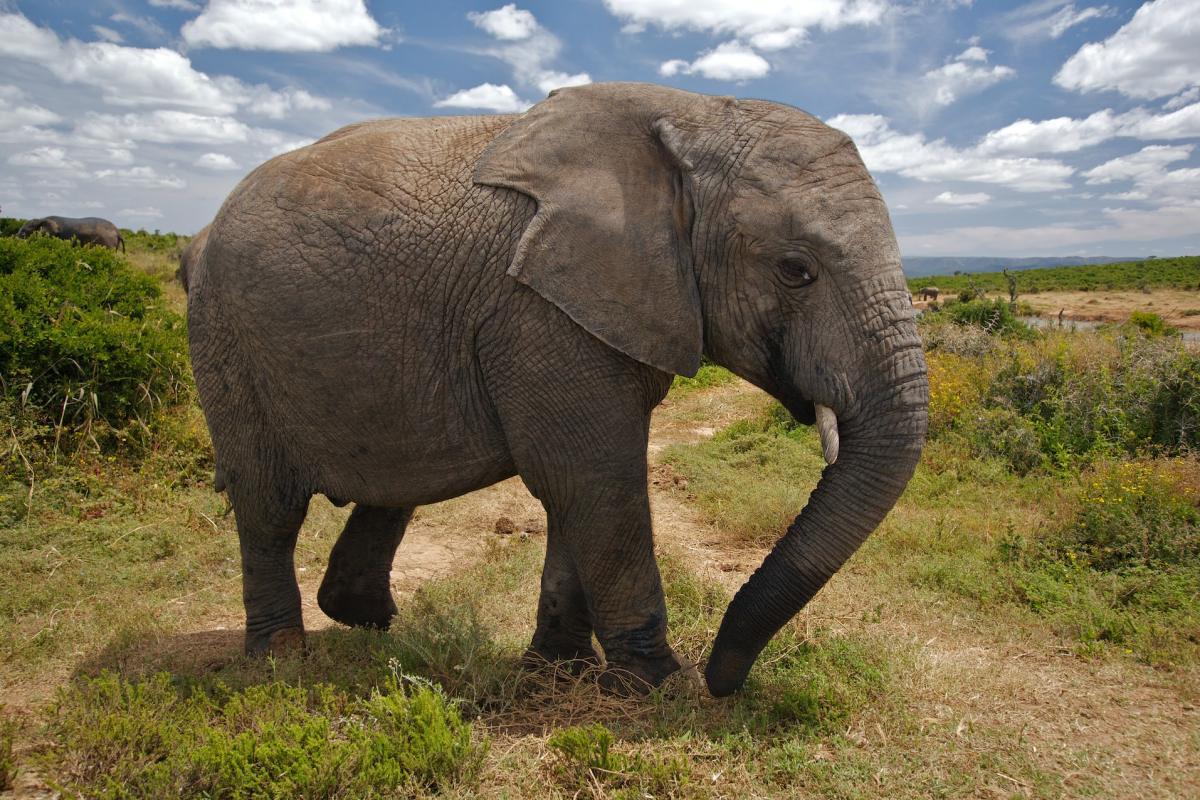
- Name: African bush elephant
- Scientific name: Loxodonta africana
- Conservation status:
The African bush elephant, or African savanna elephant, is one of two African elephant species. It is one of the most iconic wild animals on the planet but is sadly severely endangered.
Male elephants are targeted by poachers, which seriously affects the chances of survival of the species, as only females remain. They also have to face habitat changes and diseases like anthrax, which killed more than 100 elephants in Botswana alone in 2019.
5. Red-footed falcon
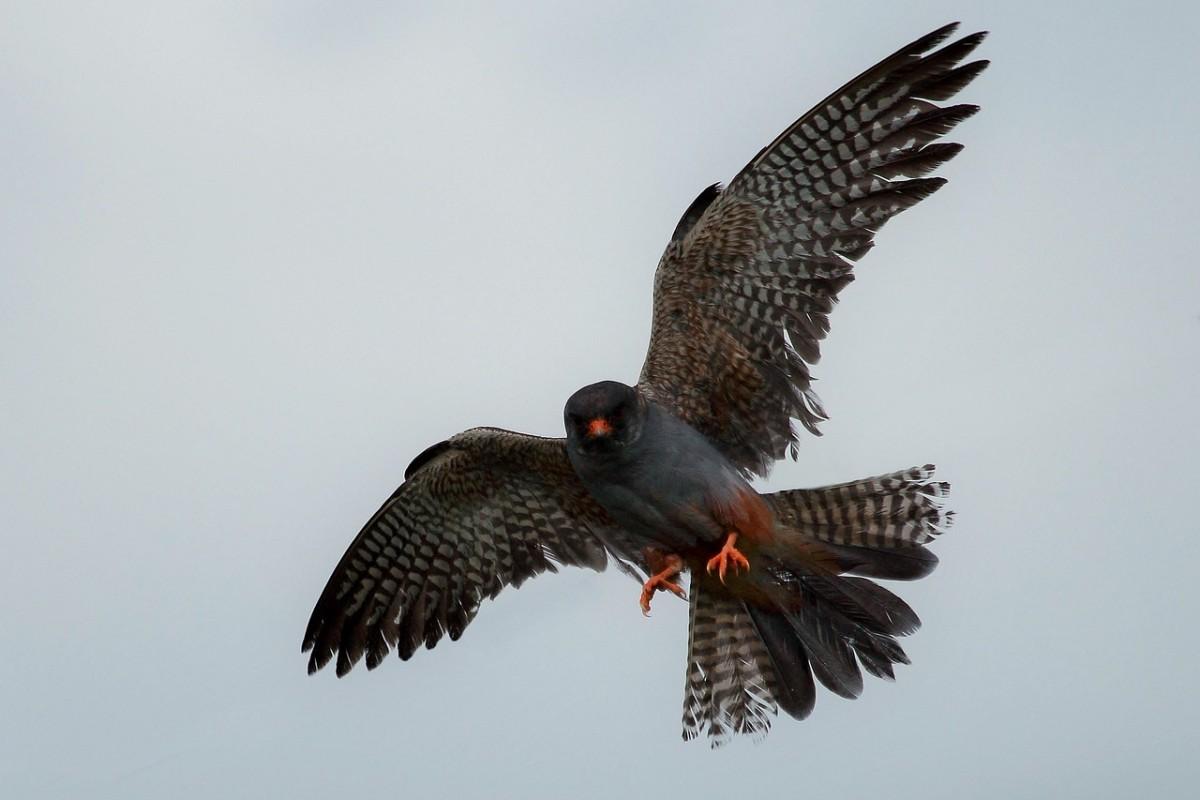
- Name: Red-footed falcon
- Scientific name: Falco vespertinus
- Conservation status:
The red-footed falcon is, despite its small size, a bird of prey. It can be found in Europe, Asia, and Africa, where it respectively passes by, breeds and lives. Its diet is mostly made of insects, amphibians, birds, mammals, and reptiles.
Red-footed falcons are threatened by the loss of natural nest sites, hunting, pesticides, electrocution, and poisoning. Its global population is estimated to be 300,000 to 800,000 individuals.
6. African striped weasel
- Name: African striped weasel
- Scientific name: Poecilogale albinucha
- Conservation status:
The African striped weasel is one of the smallest carnivorous mammals in Africa, with an elongated body and short legs. It gets its name from the black and white stripes on its back.
This weasel is a nocturnal hunter that feeds on birds, reptiles, and small mammals, even though its diet is largely made of rodents, up to its own size. It is most of the time a solitary animal, but it can pair up to dig burrows.
7. Amur falcon
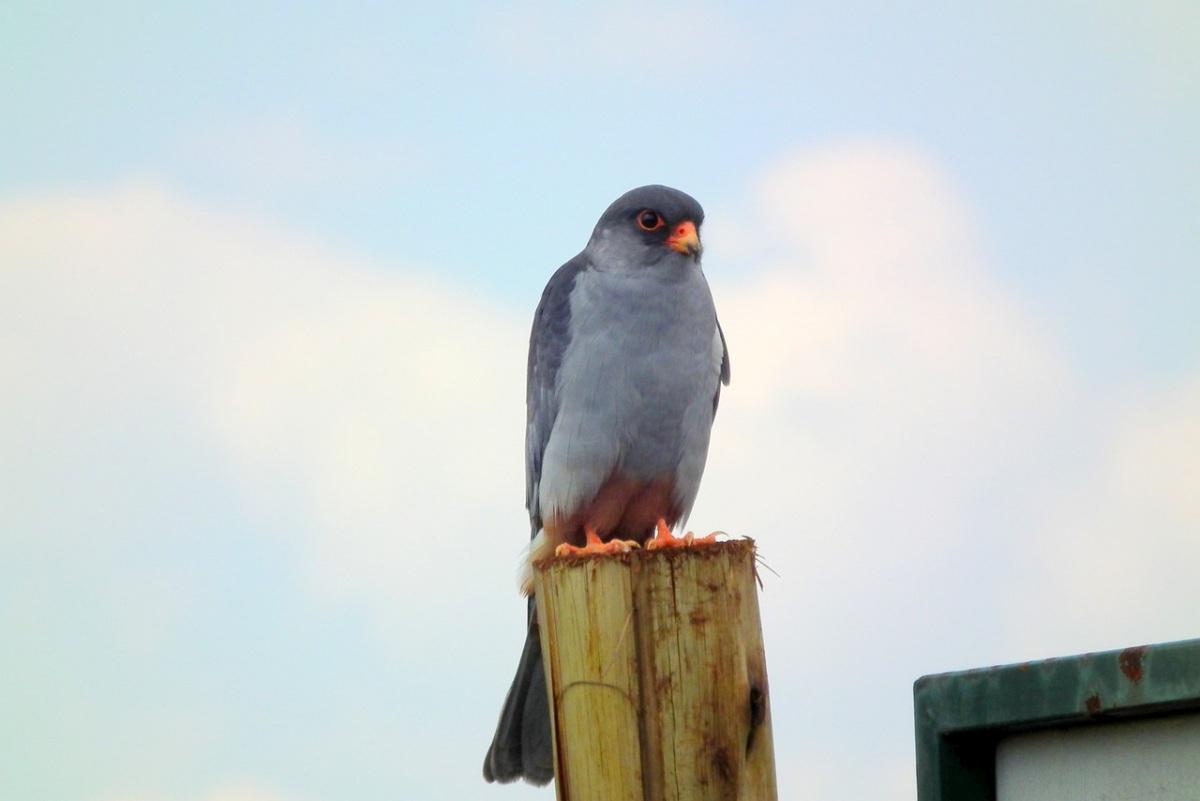
- Name: Amur falcon
- Scientific name: Falco amurensis
- Conservation status:
The Amur falcon is a small species of falcon that can be found from Siberia and North China to southern Africa, depending on the season. It breeds in northeastern Asia but lives in Africa most of the time.
It hunts late in the evening or early in the morning for insects, small birds, and mammals. Most of the time, it catches its prey mid-flight. The breeding season of the Amur falcon is from May to June.
8. Blue duiker
- Name: Blue duiker
- Scientific name: Philantomba monticola
- Conservation status:
The blue duiker is yet another peculiar animal that you might not know of. It is a small antelope native to southern and eastern Africa. Surprisingly enough, female blue duikers are larger than males, and they both have short spiky horns and dark tails.
It is only active during the day, and lives in a variety of forests, as long as it can find shelter. Despite being listed as least concern, it is threatened by hunting for its meat.
9. Barn swallow
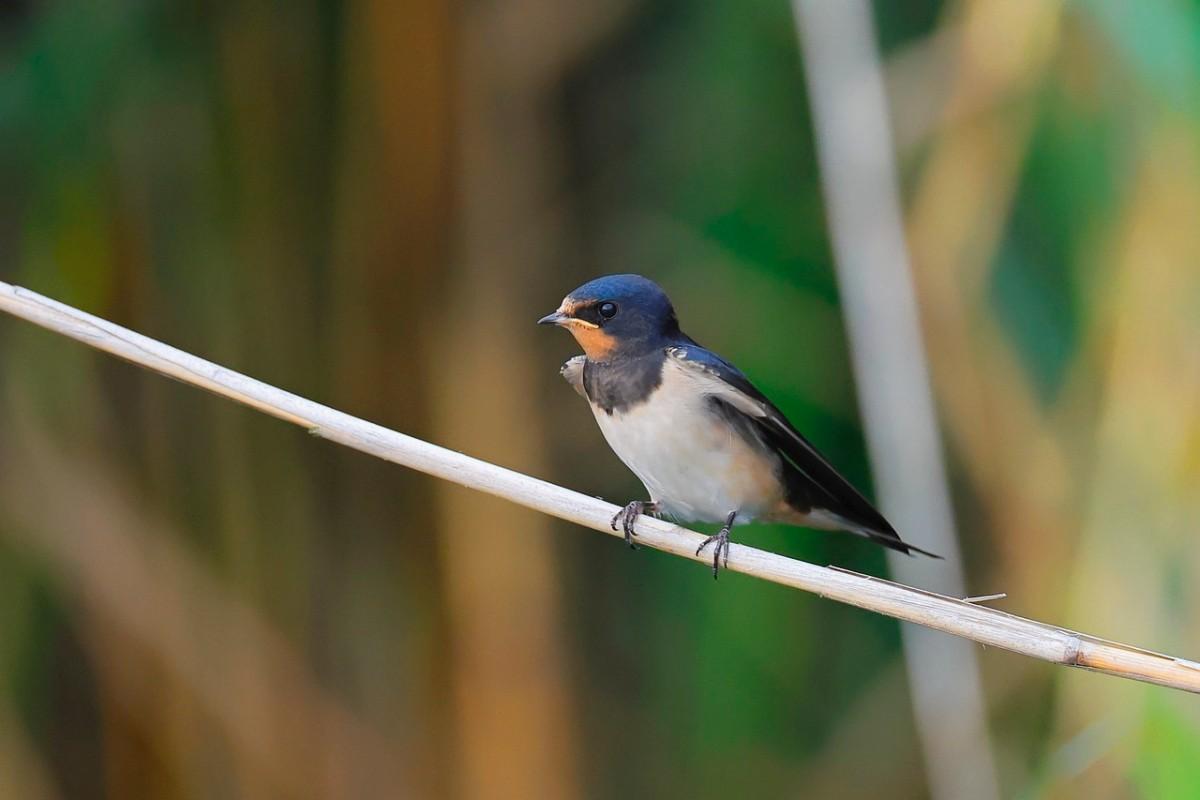
- Name: Barn swallow
- Scientific name: Hirundo rustica
- Conservation status:
The barn swallow is the most common and widespread species of a swallow on the planet. Globally, it can be found in an area of more than 251 million square kilometers. It breeds in the Northern Hemisphere and migrates to Africa and other southern continents during the winter.
It feeds on insects caught in flight, and it often interacts with humans, who largely tolerate them. There are several cultural references to the barn swallow in religious and literary pieces.
10. Burchell’s zebra
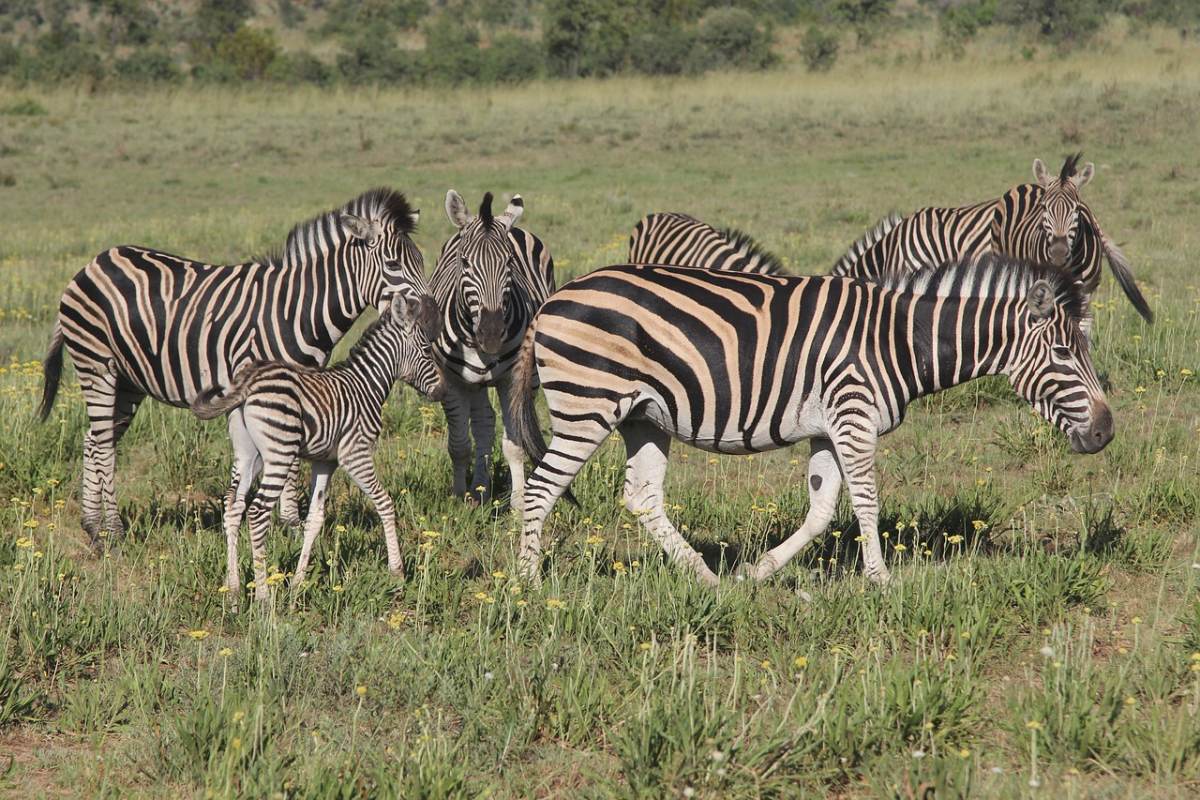
- Name: Burchell’s zebra
- Scientific name: Equus quagga burchellii
- Conservation status:
Burchell’s zebra, also known as bonte quagga, Zululand zebra, or Damaraland zebra, is a species of plain zebras that inhabits the southern part of Africa. It was named in honor of the British naturalist and explorer William John Burchell.
It is the only species of zebra that can be legally farmed for human consumption. Just like other zebras, it lives in family groups made of one stallion and one to six mares, as well as their offspring.
11. African leopard
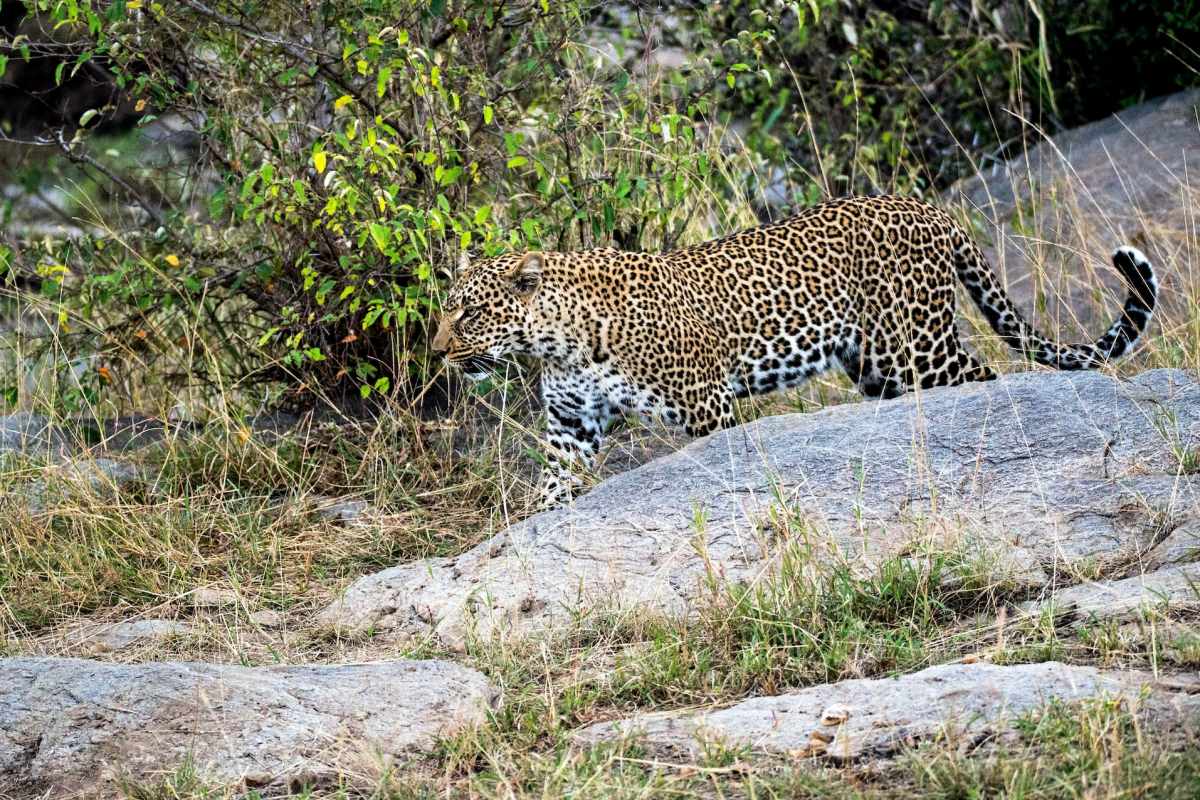
- Name: African leopard
- Scientific name: Panthera pardus pardus
- Conservation status:
The African leopard is a widely distributed species of leopard native to the African continent. Due to habitat conversion, its range has been largely modified throughout the decades, and some individuals were even recorded in northern Africa, though it usually inhabits sub-Saharan Africa.
African leopards are particularly versatile and will adapt to any prey they can feed on. When it cannot find any large ungulate, its preferred prey, it will feed on small mammals and even dung beetles.
12. Meerkat
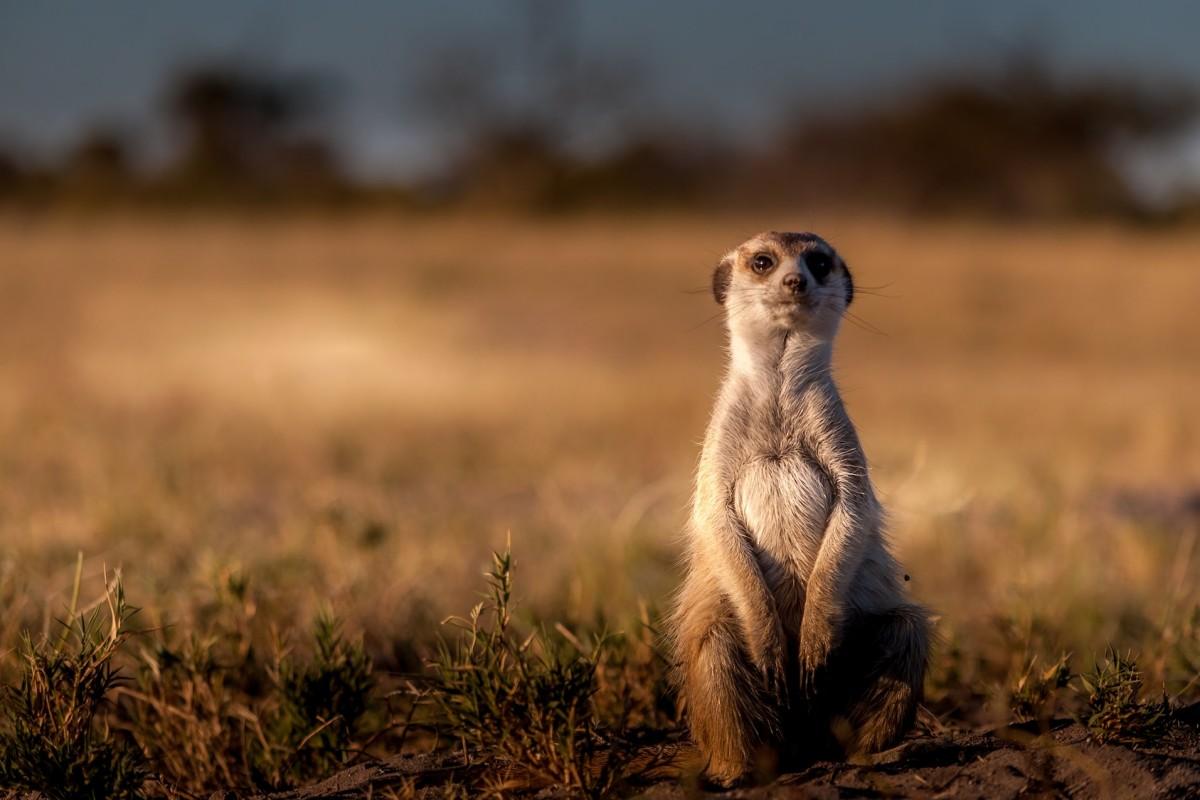
- Name: Meerkat
- Scientific name: Suricata suricatta
- Conservation status:
The meerkat, commonly known as the suricate, is a small species of mongoose native to southern Africa. It is famous for being a highly social animal that will form packs of 2 to 30 individuals, with a social hierarchy, and for surveying its surroundings by standing on its hind legs and turning its head from side to side.
When members of different packs meet, the encounter is highly aggressive and it can lead to severe injuries and even deaths.
13. Ground pangolin
- Name: Ground pangolin
- Scientific name: Smutsia temminckii
- Conservation status:
The ground pangolin, also known as the steppe pangolin, the Cape pangolin, or Temminck’s pangolin, is one of the four African species of pangolin. Pangolins, as a whole, are some of the most critically endangered species on the planet, and the ground pangolin is no exception to that. It is mainly threatened by illegal trafficking and habitat loss.
Like other pangolins, the ground pangolin is almost entirely covered in protective scales, which make up around 20 percent of its body weight.
14. Southeast African cheetah
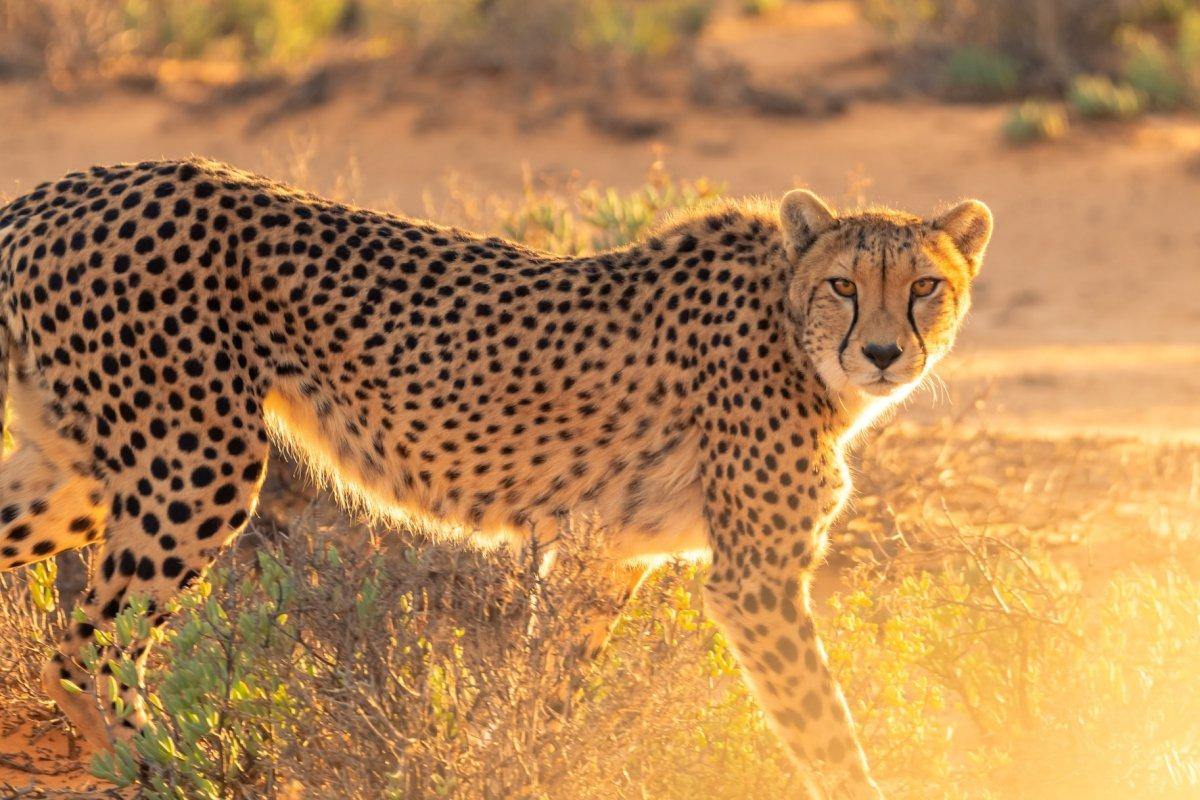
- Name: Southeast African cheetah
- Scientific name: Acinonyx jubatus jubatus
- Conservation status:
Cheetahs are emblematic African animals that inhabit savannahs, deserts, and lowland areas. They are known for being the fastest land animal on Earth, and they have very athletic and thin bodies.
The Southeast African cheetah is, as its name suggests, the southern and eastern subspecies of the African cheetah. It generally inhabits the desert of the Kalahari, which represents around 80 percent of Botswana’s area, and it is threatened by habitat loss, lack of prey, and poaching.
15. Bat-eared fox
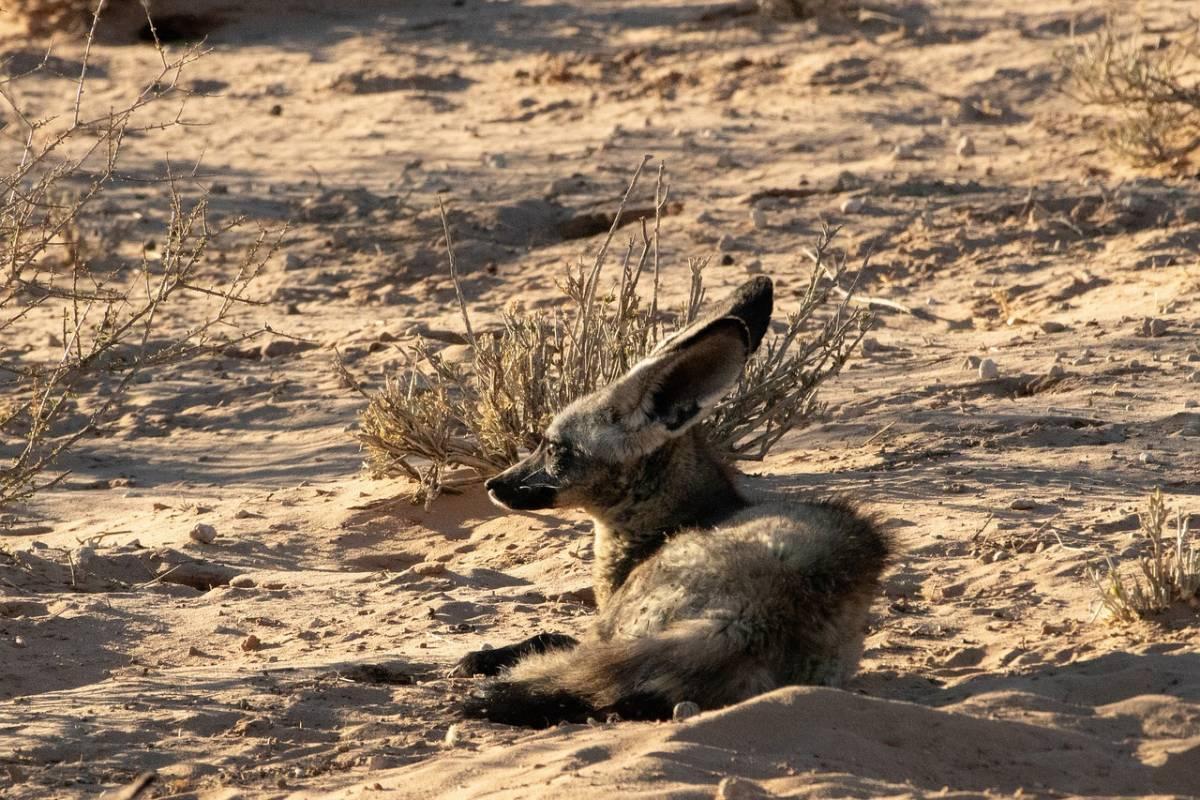
- Name: Bat-eared fox
- Scientific name: Otocyon megalotis
- Conservation status:
The bat-eared fox is a species of the fox with unusually large ears, which is where it gets its name from. These ears are used for thermoregulation, just like the fennec fox in North Africa, and they are compared to the Egyptian slit-faced bat, abundant in the region despite its name.
This fox inhabits arid environments, usually short grasslands and savannas. It is the only truly insectivorous canid, and its diet is made of 80 to 90 percent of harvester termites.
16. Southern African lion
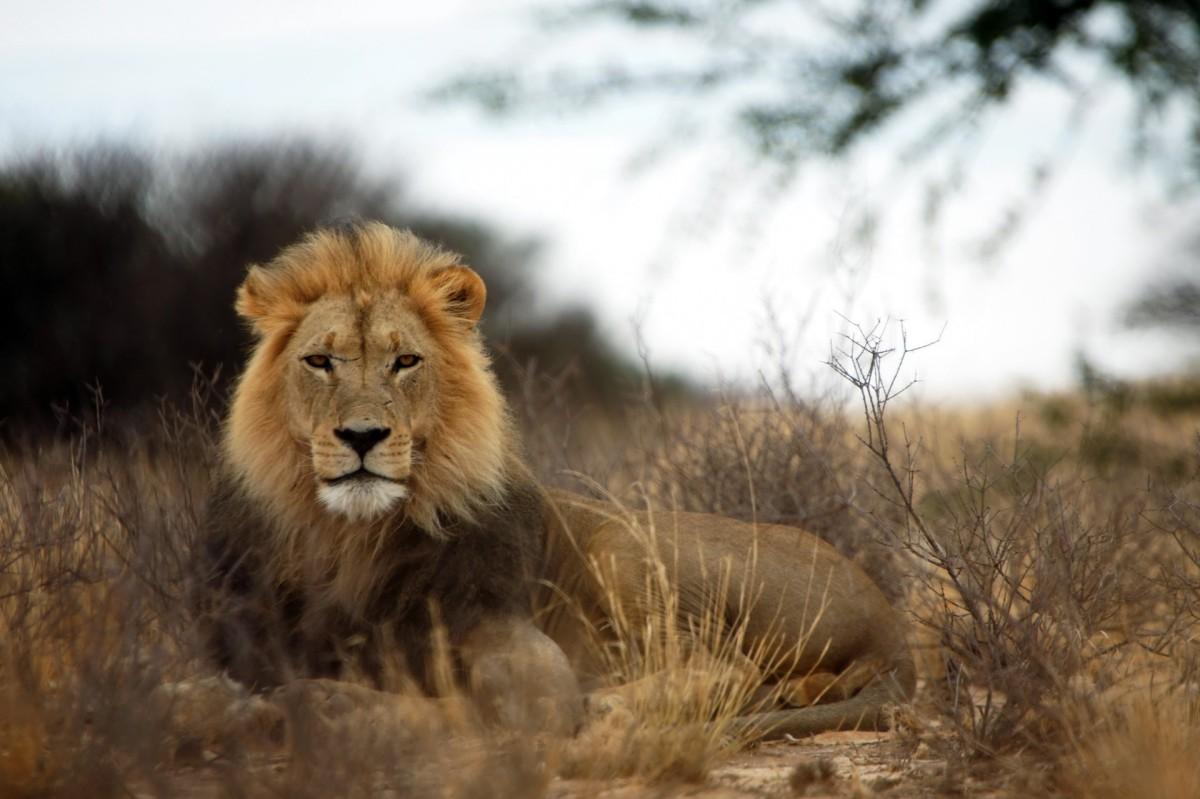
- Name: Southern African lion
- Scientific name: Panthera leo melanochaita
- Conservation status:
The lion, the king of the jungle, had to make its way on this list. This subspecies, the Southern African lion, is the one that can be found in Botswana, and that is strictly protected in several areas. It is locally extinct in Djibouti, Eritrea, and Lesotho.
There are even some very rare white lions, but they were removed from the wild during the 1970s. Instead, they are bred in captivity, and often used as trophies during canned hunts.
17. Kirk’s dik-dik
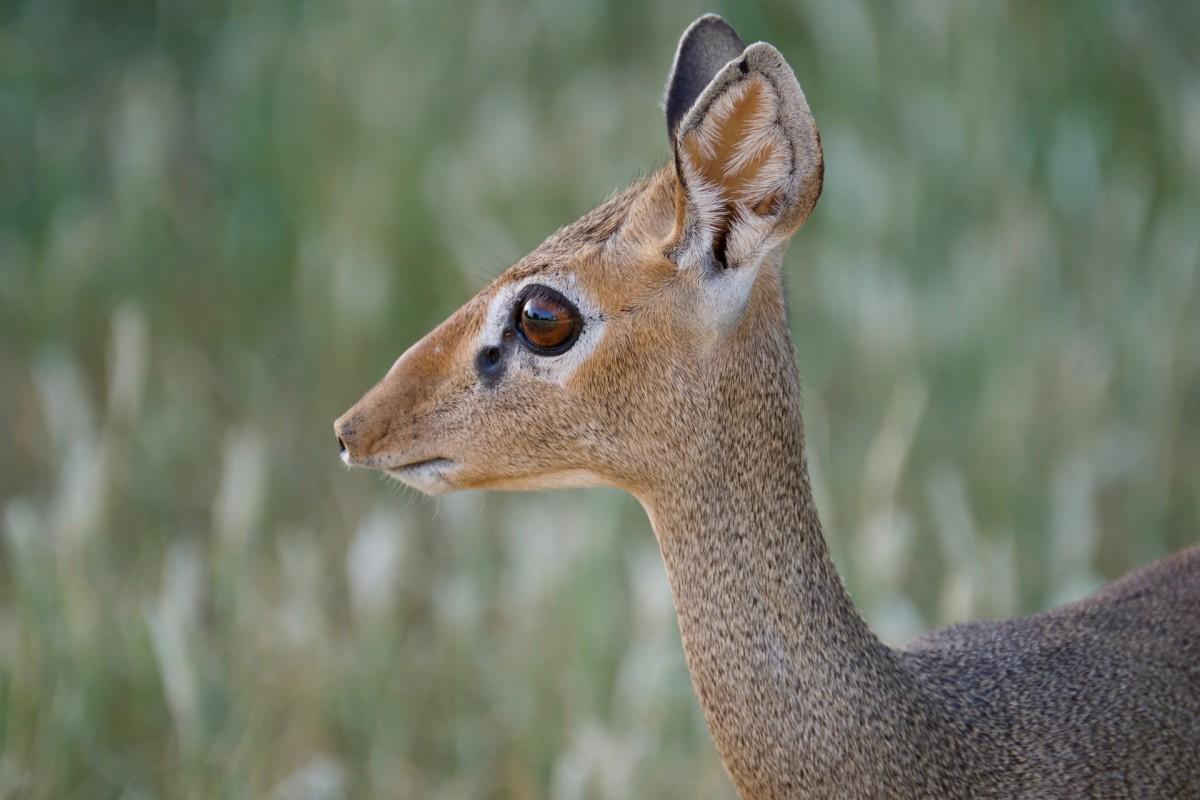
- Name: Kirk’s dik-dik
- Scientific name: Madoqua kirkii
- Conservation status:
Kirk’s dik-dik is a small species of antelope that you might not know of. It is one of the four species of dik-dik antelopes, and despite its small size, it can reach up to 42 km/h / 26 mph. Dik-diks are one of the smallest antelopes in the world, and Kirk’s dik-dik is the largest of them. These animals have large ears and eyes, and small horns on males only.
18. Serval
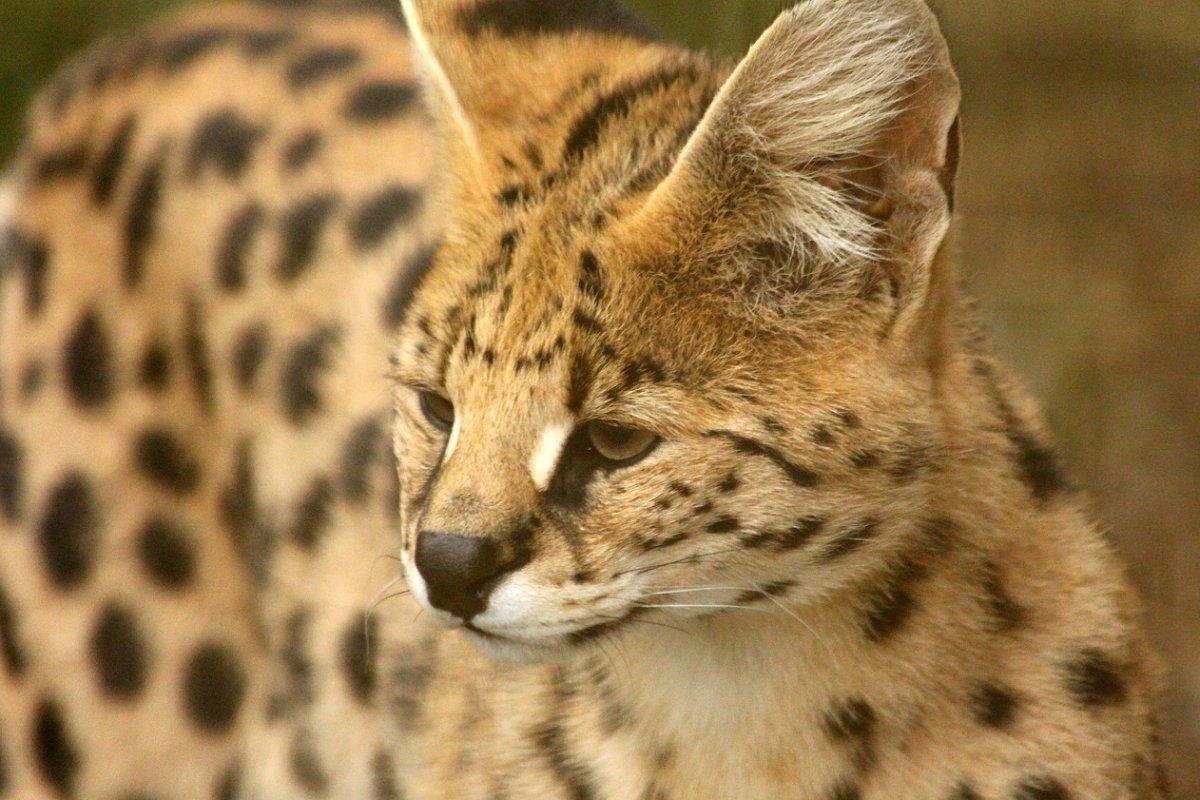
- Name: Serval
- Scientific name: Leptailurus serval
- Conservation status:
The serval is a species of wild cat native to sub-Saharan Africa. It has a small head, large ears, and a golden coat spotted and striped with black.
This animal is solitary and carnivorous and is active both by day and at night. It feeds on rodents, birds, reptiles, insects, and frogs, using its particularly good sense of hearing to locate prey. Usually, it leaps over 2 m / 6 ft 7 to then land on its prey and kill it with a bite on the neck.
19. Waterbuck
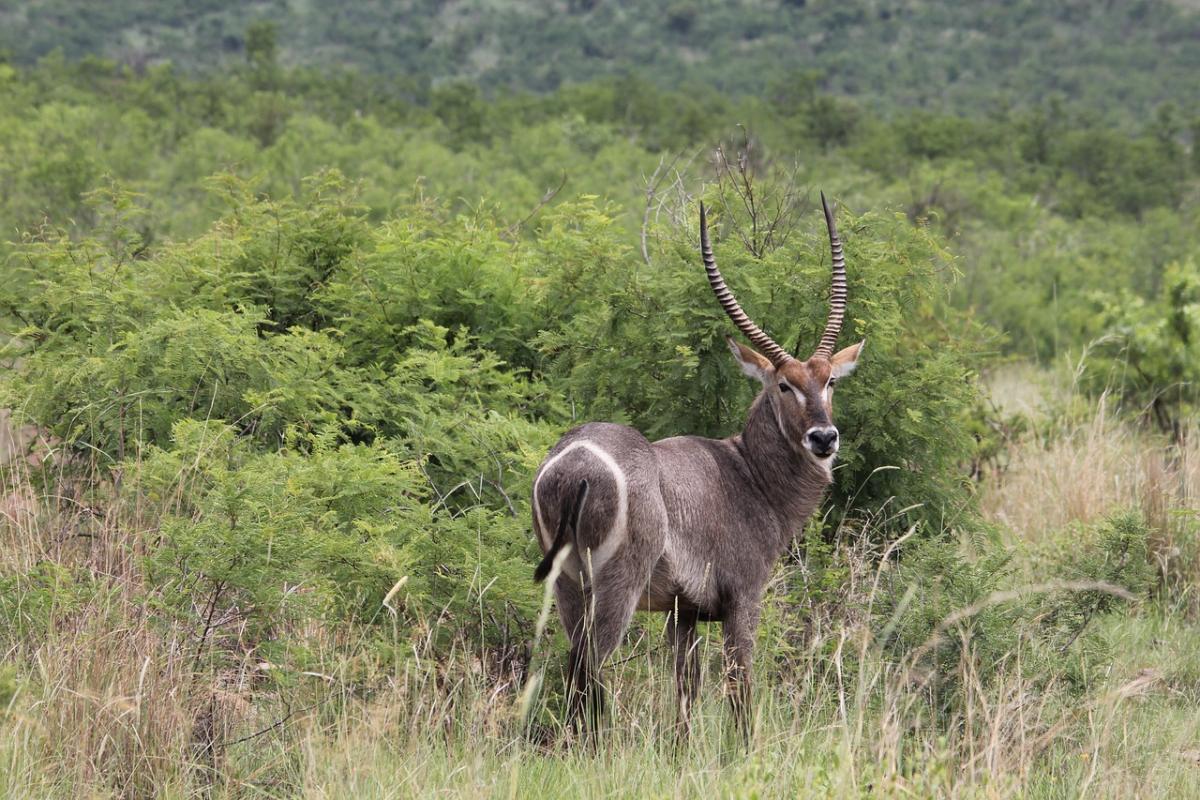
- Name: Waterbuck
- Scientific name: Kobus ellipsiprymnus
- Conservation status:
The waterbuck is a large species of antelope that can be found in all of sub-Saharan Africa. Only males have long and spiral horns, which usually range from 55 to 99 cm (22 to 39 in) long.
Waterbucks live in herds of 6 to 30 individuals, and they are quite sedentary. They always stay near bodies of water, as they cannot tolerate dehydration. Though it is considered of least concern, for now, its population is on the decline, due to human disturbance and poaching.
20. Angolan giraffe
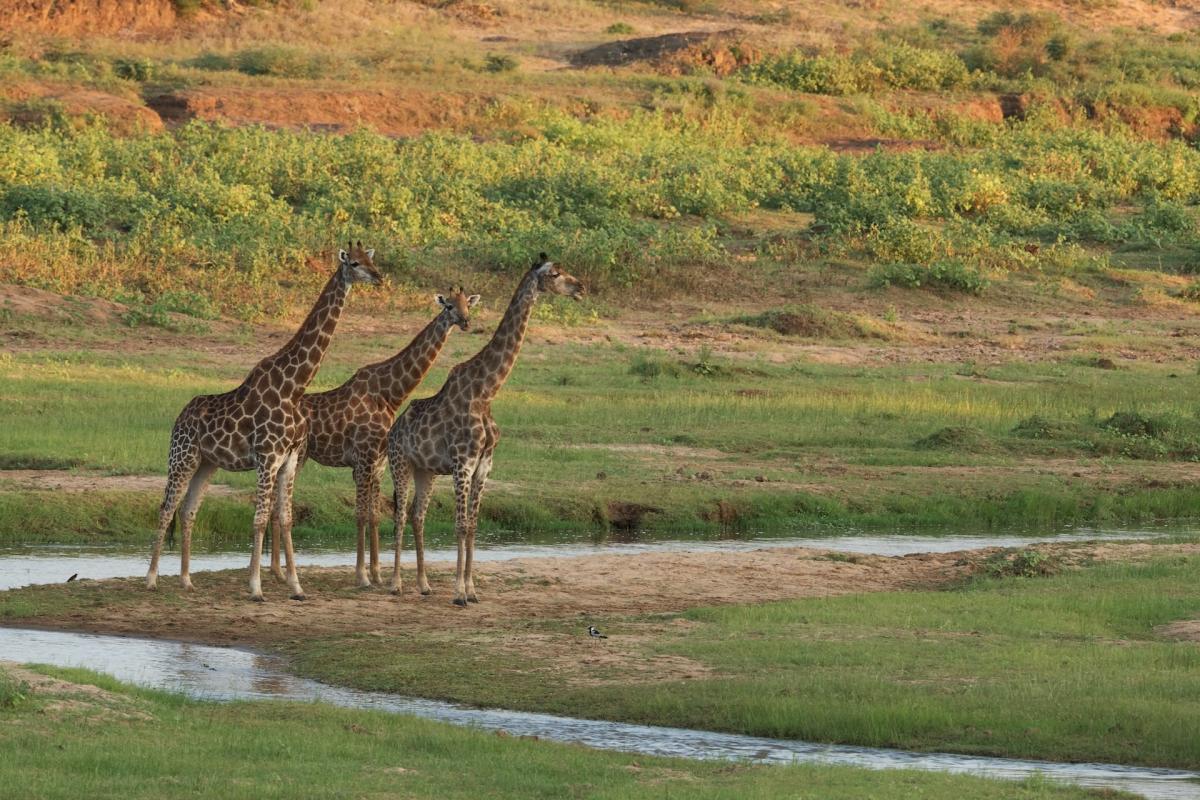
- Name: Angolan giraffe
- Scientific name: Giraffa camelopardalis angolensis
- Conservation status:
The Angolan giraffe, or Namibian giraffe, is a species of giraffe that inhabits Namibia, Angola, Botswana, Zimbabwe, and Zambia. There are 20 Angolan giraffes in zoos and around 13,000 in the wild.
Their characteristic brown blotches are angular, and their spotting pattern runs from the legs to the head. On the neck, blotches are smaller, and this giraffe has a white ear patch.
21. Common warthog
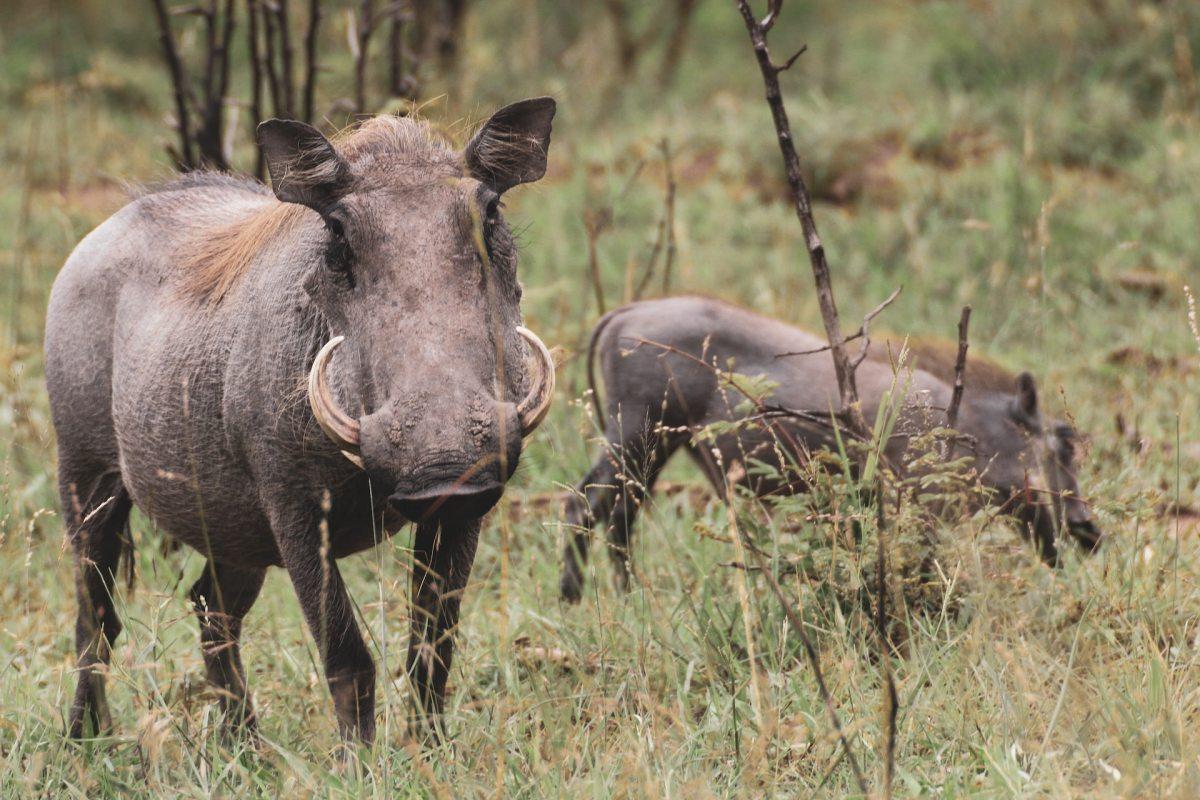
- Name: Common warthog
- Scientific name: Phacochoerus africanus
- Conservation status:
The common warthog is a wild species of the pig family. Similar to wild boars, it inhabits grassland, woodland, and savanna, in sub-Saharan Africa. It is in fact the only pig species that has adapted to savanna habitats. It is an omnivorous animal that can eat anything from grasses, roots, and fruits to insects, carrion, and eggs.
Even though it can fight, and male common warthogs often do, its best defense is to run away. Believe it or not, it can run at up to 48 km/h / 30 mph, sometimes outspeeding predators like African leopards!
22. Springbok
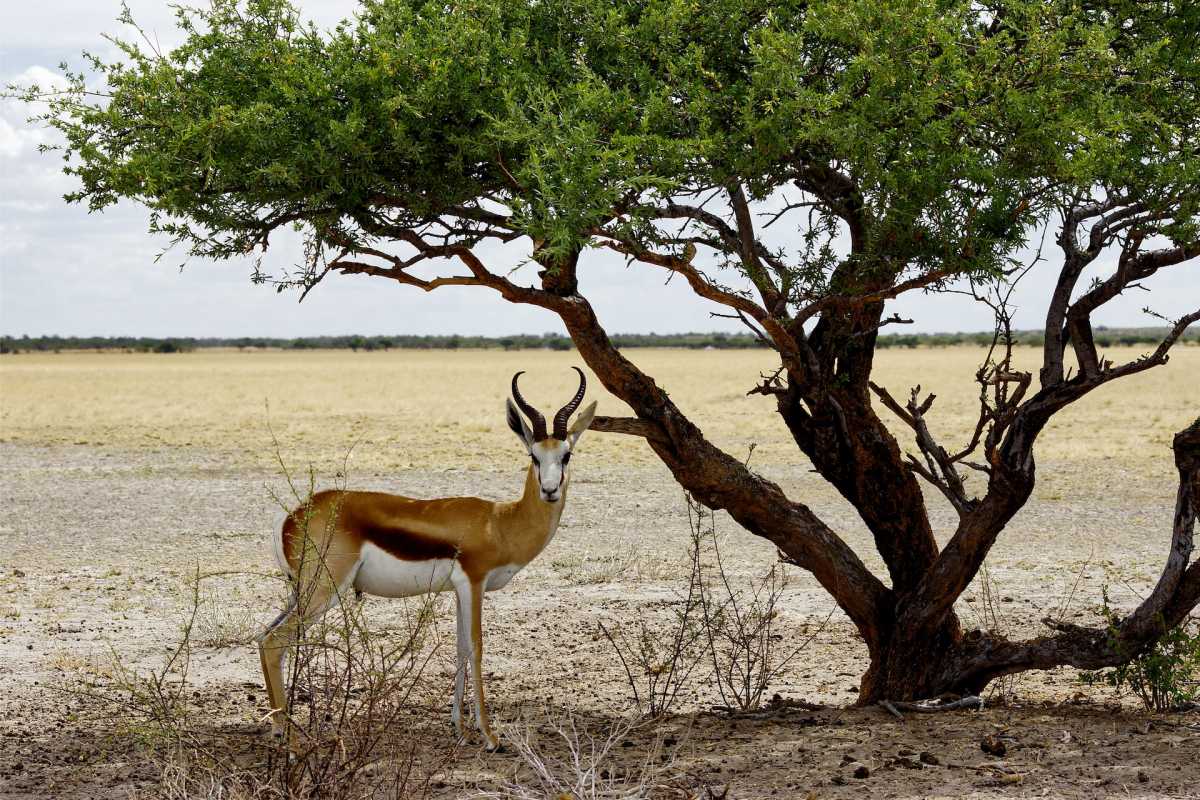
- Name: Springbok
- Scientific name: Antidorcas marsupialis
- Conservation status:
You may have already heard the name “Springbok”, as this medium-sized antelope gives its name to the South African men’s national rugby team.
This antelope lives in harems and is active at dawn and dusk. One of the most notorious features of the springbok, which it shares with other antelopes, is stotting or pronking, which is the peculiar way in which it runs by jumping on all four feet at once.
23. South-central black rhinoceros
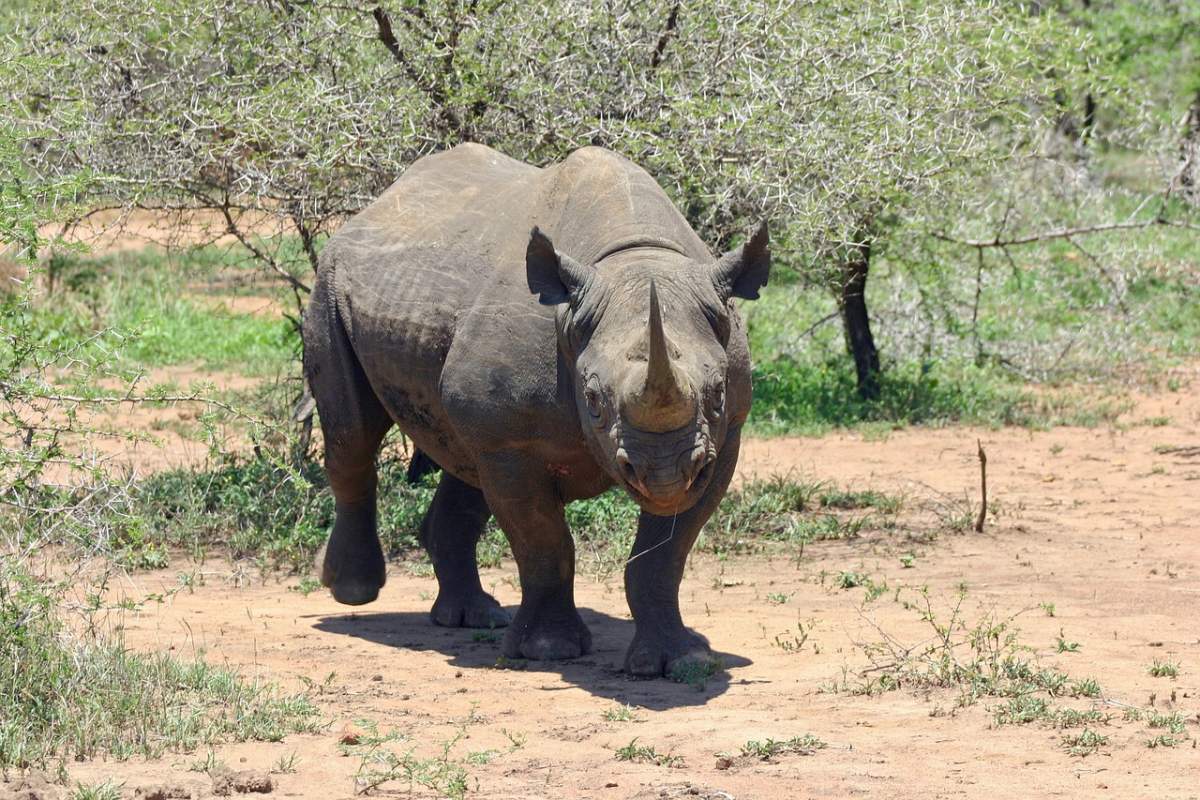
- Name: South-central black rhinoceros
- Scientific name: Diceros bicornis minor
- Conservation status:
The South-central black rhino, also known as the south-central hook-lipped rhinoceros, is a subspecies of the black rhinoceros, one of the most infamously critically endangered large species of Africa. Over the course of the past 50 years, its population has declined by 90 percent, and there are only around 2,000 wild individuals.
While they are mainly threatened by illegal poaching for their horns, these rhinos can count on conservation efforts and protective laws, and their population is now slightly increasing.
24. Rock hyrax
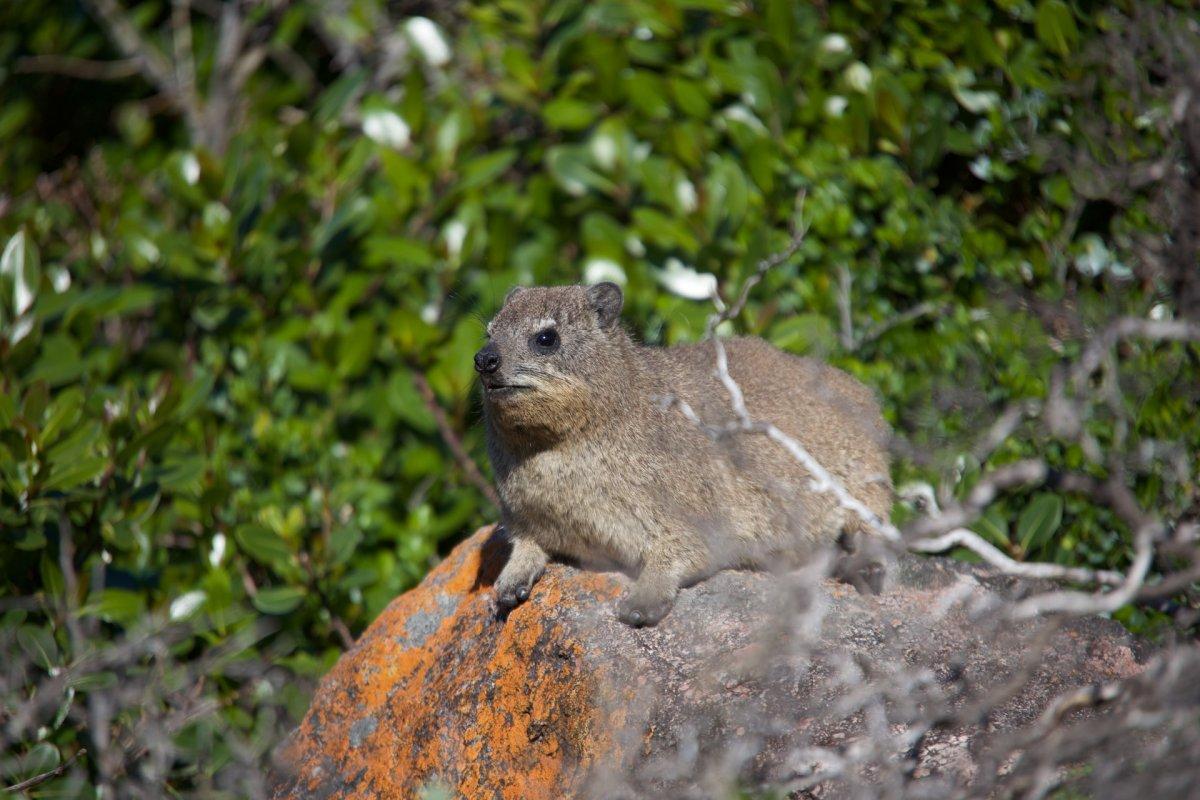
- Name: Rock hyrax
- Scientific name: Procavia capensis
- Conservation status:
The rock hyrax, also known as the dassie, the Cape hyrax, the coney, and the rock rabbit, is a medium-sized species of mammal native to the Middle East and Africa. It lives in elevations up to 4,200 m / 13,800 ft above sea level and is active early in the morning and late in the evening.
In some areas, it is considered a minor pest, and it can carry parasites. Besides, though this sounds surreal, the rock hyrax is most closely related to… the elephant!
25. Blue wildebeest
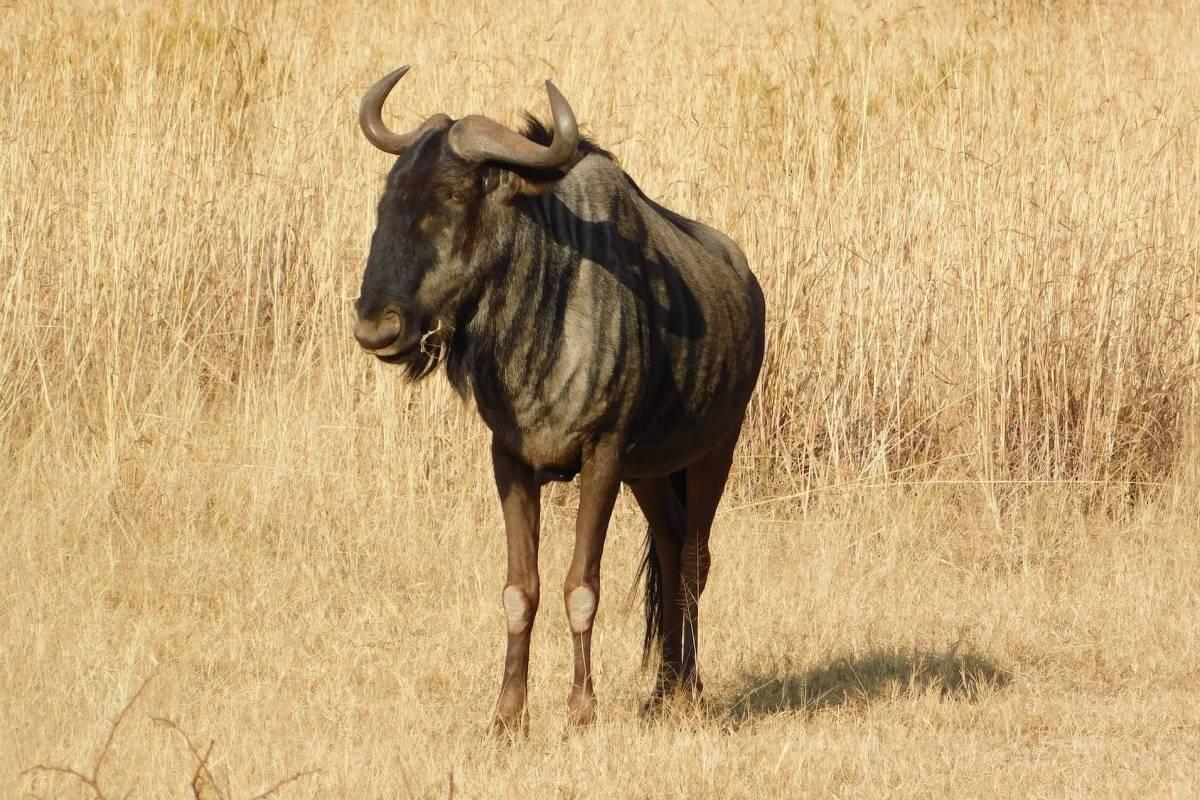
- Name: Blue wildebeest
- Scientific name: Connochaetes taurinus
- Conservation status:
The blue wildebeest, also known as the white-bearded gnu, the brindled gnu, or the common wildebeest, is a species of large antelope, though it does not look like one. It is a herbivorous animal that feeds on short grasses and lives in large herds.
These wildebeest are some of the favorite prey for predators such as leopards, cheetahs, lions, and crocodiles. They target the weak, young, and old individuals, which are left behind.
26. Gemsbok

- Name: Gemsbok
- Scientific name: Oryx gazella
- Conservation status:
The gemsbok, more commonly known as the South African oryx, is a large species of antelope that belongs to the genus Oryx. It lives in arid regions of southern Africa such as the Kalahari Desert and is represented on the coat of arms of Namibia.
Its name comes from Afrikaans, and it means chamois, though the 2 species have nothing to do with each other. The gemsbok is tan in color and has characteristic long and straight horns, which is what it is largely hunted for. These horns average 85 cm / 33 in length, and they are truly spectacular.
27. Black-footed cat
- Name: Black-footed cat
- Scientific name: Felis nigripes
- Conservation status:
A small species of wild cat like the black-spotted cat, also known as the small-spotted cat, is probably not what you would expect to find in the arid African wilderness, and it sounds like it has no chance to survive.
However, this little cat with a very restricted distribution hunts at night, no matter the temperature. Obviously, it cannot hunt large ungulates like gnus and antelopes, but it can still survive by eating small birds, rodents, and Cape hares… though the latter are heavier than itself.
28. Spotted hyena
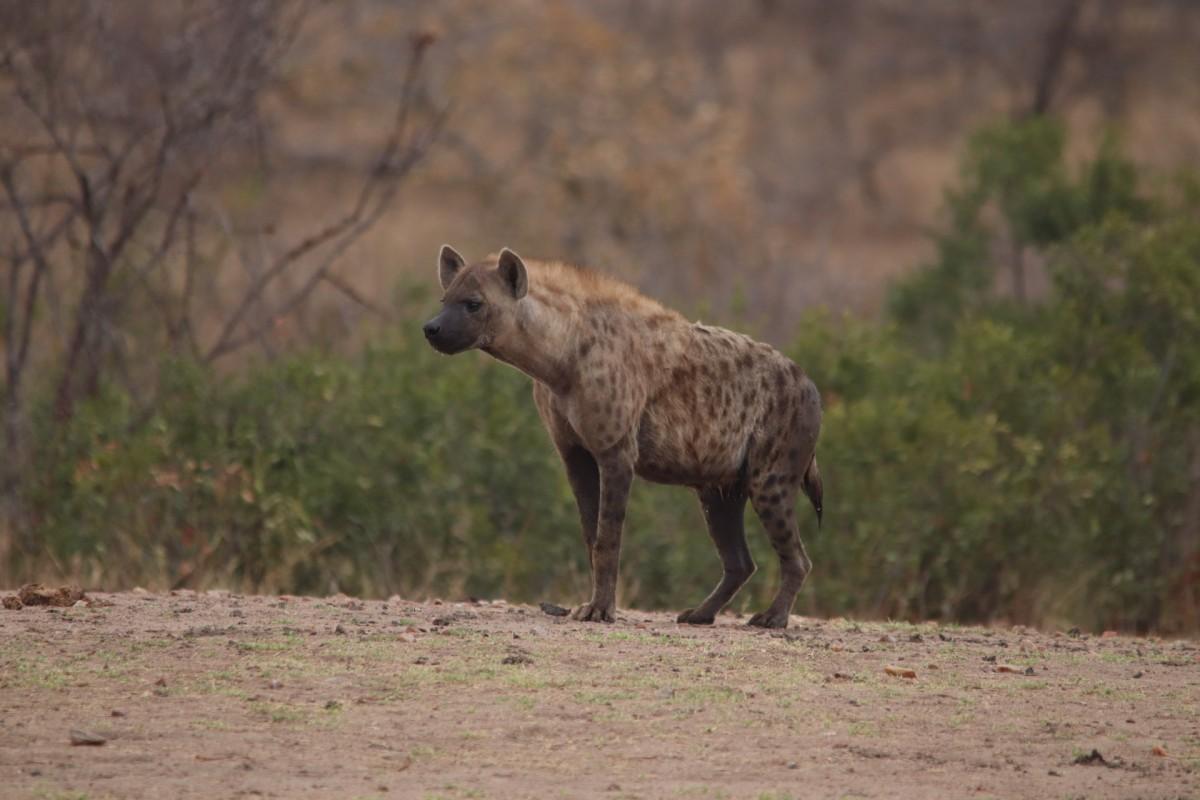
- Name: Spotted hyena
- Scientific name: Crocuta crocuta
- Conservation status:
You may already know about the spotted hyena due to its characteristic vocalization that sounds like a laugh, which is what gave it its other name, the laughing hyena.
It is very successful as a species due to its adaptability and opportunism. As a result, it is the most common large carnivore in Africa, and it feeds by either hunting or scavenging. Despite this, its global population is still on the decline due to poaching and habitat loss.
—
So there you have them, these were my 28 animals of the Botswana wildlife. I hope you enjoyed this list and that you learned something new today.
In case you want to learn more about the wildlife of Botswana, feel free to keep reading, as I still have lots of things to tell you about:
Endangered Animals of Botswana
This is definitely the saddest part of the list, but it is very important to raise awareness. Because of this, let’s go through the list of endangered animals in Botswana.
Here are the animals in danger of extinction in Botswana.
- None
- White-backed vulture
- White-headed vulture
- Black rhino
- Hooded vulture
- Rüppell’s vulture
- Secretarybird
- Steppe eagle
- African savanna elephant
- Black harrier
- Grey crowned crane
- and 9 more…
To see the full list of endangered species in Botswana, head over to the International Union for Conservation of Nature’s Red List.
What is the National Animal of Botswana?
The national animal of Botswana is the zebra.
In Botswana, there are lots of tribes. Historically, there have been tensions and even wars between them. Because of this, the national animal is the zebra: it is considered to be neutral and does not represent any tribal symbol, making it the perfect animal for national unity.
On top of this, its black and white colors resonate with the Botswana flag, which is supposed to represent racial harmony as well as multiethnic populations.
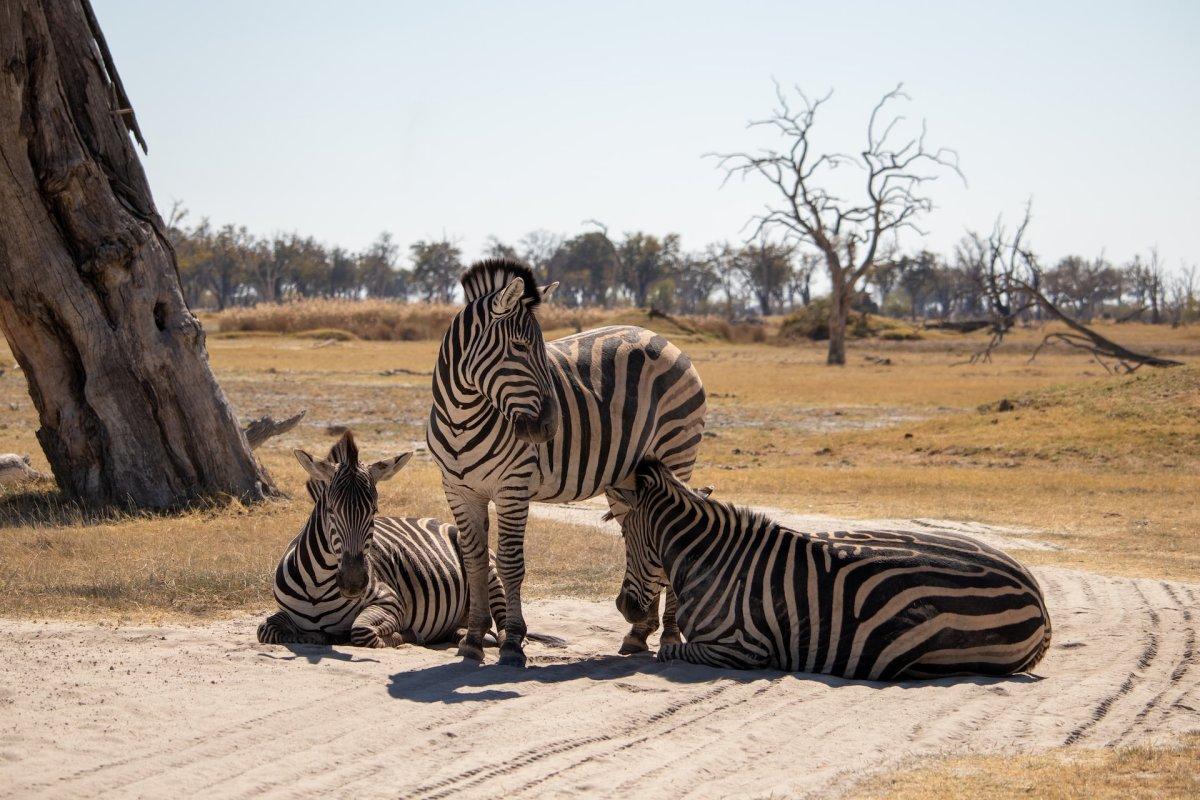
How Many Animals Native to Botswana?
What is the diversity of native animals in Botswana?
Let’s look at the total number of species of Chordata (mammals, birds, fishes, and reptiles).
Total number of animal species in Botswana: 1,018 (14,098 in total in Sub-Saharan Africa)
More About Animals in the World!
Loved these facts about Botswana animals? Want to see what animals live in other countries?
Then check out these posts:
Or click here to see ALL the facts up on the blog! Spoiler alert: there’s A LOT of them.
Share the knowledge! Click on the buttons below to share information about these famous animals that live in Botswana with your friends, and help them learn more about the world 🙂
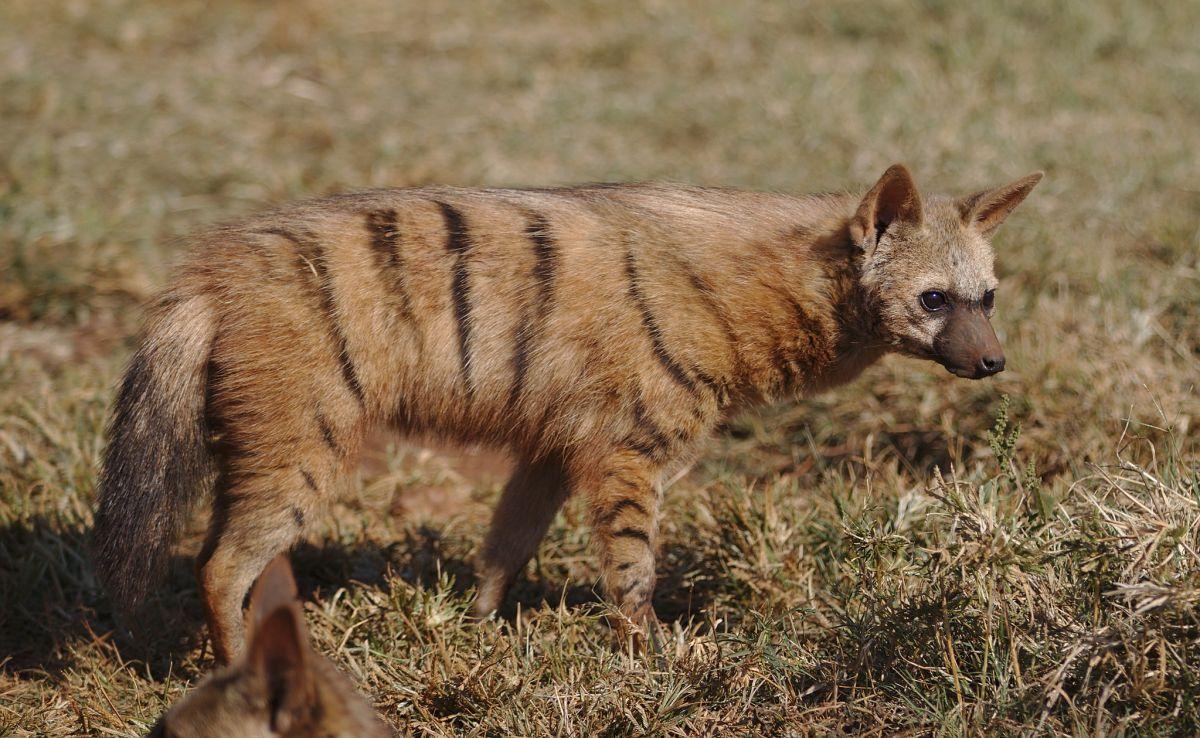
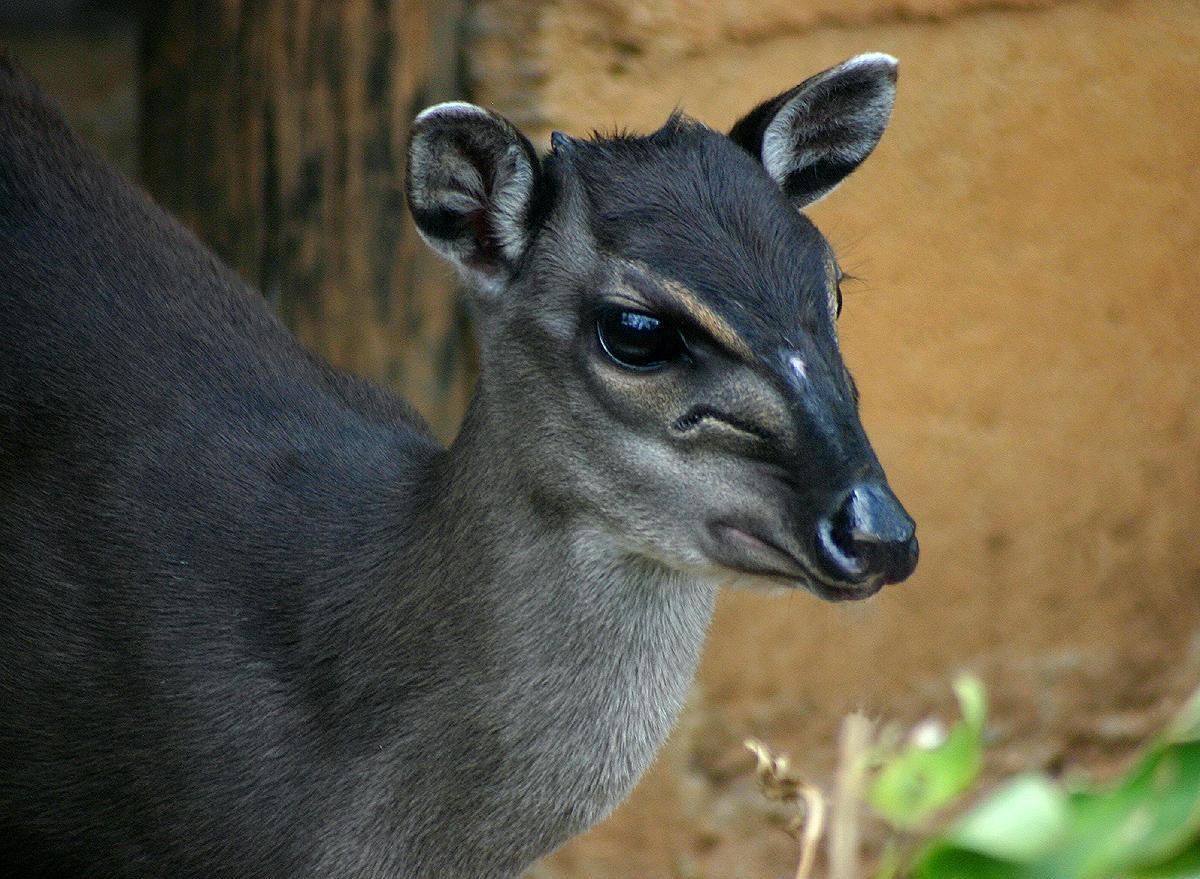
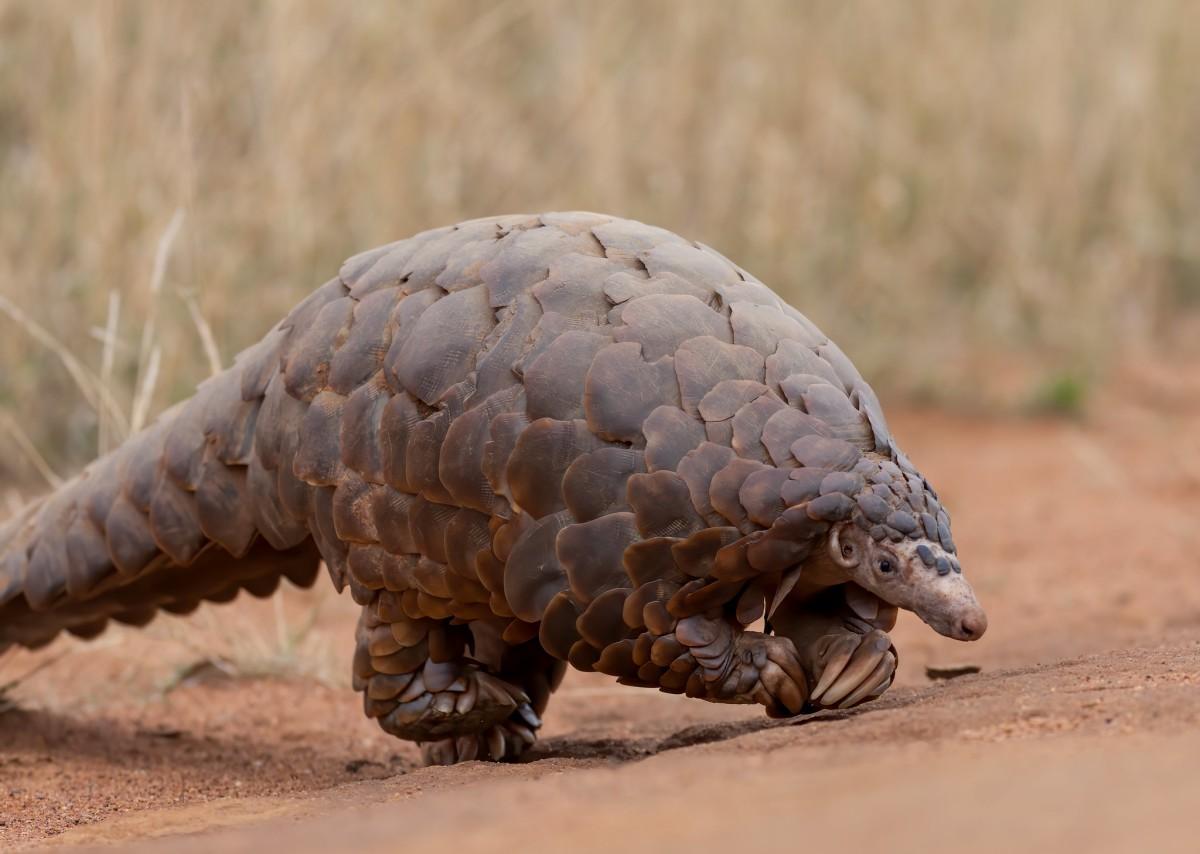
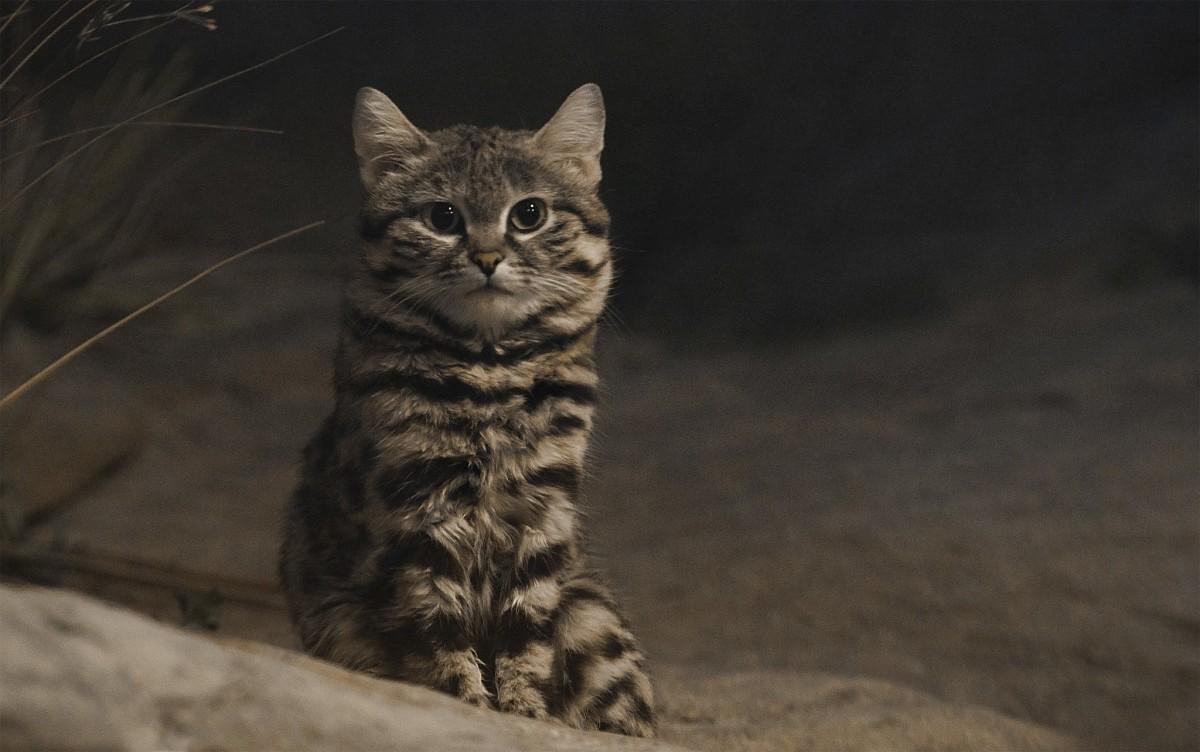

![18 Wild Animals in Maldives [Wildlife in Maldives]](https://www.kevmrc.com/wp-content/uploads/2022/12/18-wild-animals-in-maldives.jpg)
![20 Wild Animals in England [Wildlife in England]](https://www.kevmrc.com/wp-content/uploads/2022/10/20-wild-animals-in-england.jpg)
![20 Wild Animals in Lithuania [Wildlife in Lithuania]](https://www.kevmrc.com/wp-content/uploads/2022/10/20-wild-animals-in-lithuania.jpg)